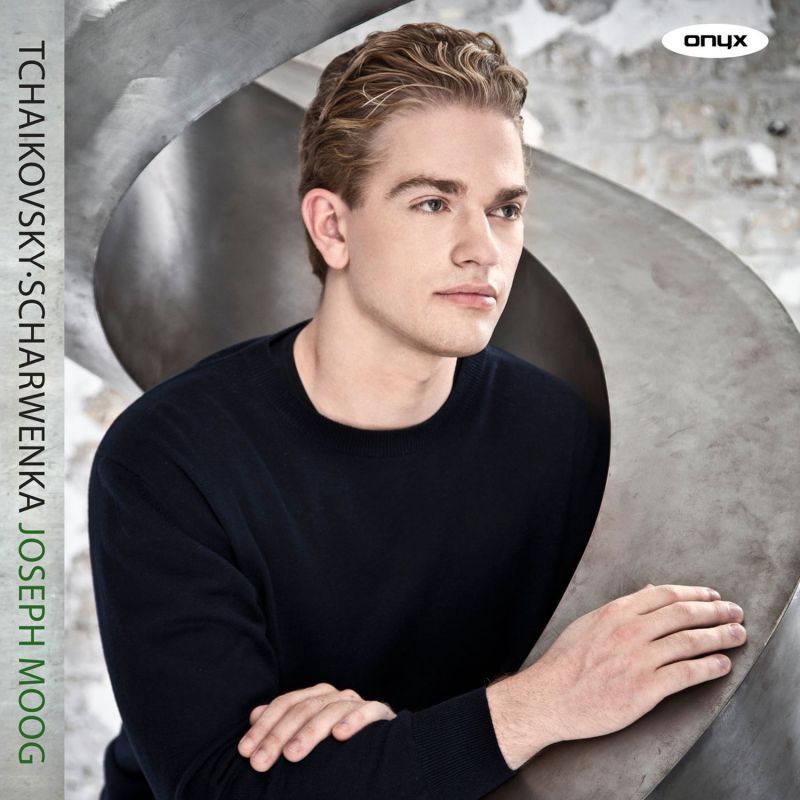TCHAIKOVSKY Grande Sonata SCHARWENKA Piano Sonata No 2
View record and artist detailsRecord and Artist Details
Composer or Director: Pyotr Ilyich Tchaikovsky, (Franz) Xaver Scharwenka
Genre:
Instrumental
Label: Onyx
Magazine Review Date: AW2014
Media Format: CD or Download
Media Runtime: 66
Mastering:
DDD
Catalogue Number: ONYX4126

Tracks:
| Composition | Artist Credit |
|---|---|
| Sonata for Piano |
Pyotr Ilyich Tchaikovsky, Composer
Joseph Moog, Piano Pyotr Ilyich Tchaikovsky, Composer |
| Romance |
Pyotr Ilyich Tchaikovsky, Composer
Joseph Moog, Piano Pyotr Ilyich Tchaikovsky, Composer |
| Aveu passioné, 'Ardent Declaration' |
Pyotr Ilyich Tchaikovsky, Composer
Joseph Moog, Piano Pyotr Ilyich Tchaikovsky, Composer |
| Sonata No. 2 |
(Franz) Xaver Scharwenka, Composer
(Franz) Xaver Scharwenka, Composer Joseph Moog, Piano |
| Im Freien, 5 Tonbilder, Movement: No 1 |
(Franz) Xaver Scharwenka, Composer
(Franz) Xaver Scharwenka, Composer Joseph Moog, Piano |
| Im Freien, 5 Tonbilder, Movement: No 2 |
(Franz) Xaver Scharwenka, Composer
(Franz) Xaver Scharwenka, Composer Joseph Moog, Piano |
Author: Jed Distler
Moog manages to convey the opening movement’s first theme’s pesante directive with animation and flexibility, along with stronger rhythmic profile in the second theme, by taking the composer’s poco rubato indication on faith. His literal yet subtly inflected approach to the slow movement’s changes in mood and texture minimalise the music’s sectional nature, although veteran pianophiles might miss Grigory Ginzburg’s affectionate tenutos and vocal robustness. Inner voices and cross-rhythmic accents account for themselves throughout Moog’s lithe, compact and deliciously scurrying Allegro giocoso. And Moog’s fabulous technique enables him to cleanly delineate the Allegro vivace finale’s massive, orchestrally inspired chords and cascading keyboard runs with maximum tutti/solo contrast and minimum tempo adjustment.
More than a mere filler, Xaver Scharwenka’s Second Sonata is a minor masterpiece in its own right, packed with soaring melodies, dense harmonic manoeuvring and an overall keyboard layout that one could mistake for Schumann (the lush doublings, the obsessive dotted rhythms). Although Seta Tanyel made a fine recording of this work for her Hyperion Scharwenka cycle, I prefer Moog’s characterful animation in the outer movements, his frolicsome fingerwork and pulverising accents in the second movement, plus his leaner, more transparent sonority all around. The variety with which Moog unfolds widely spaced chords and grace notes in the left hand makes his relatively strict tempo for the Adagio sound freer than it actually is.
The sensitive simplicity Moog brings to each composer’s shorter works sweetens the deal, notwithstanding the slightly dry sound. Jeremy Nicholas provides brief yet informative booklet-notes.
Discover the world's largest classical music catalogue with Presto Music.

Gramophone Digital Club
- Digital Edition
- Digital Archive
- Reviews Database
- Full website access
From £8.75 / month
Subscribe
Gramophone Full Club
- Print Edition
- Digital Edition
- Digital Archive
- Reviews Database
- Full website access
From £11.00 / month
Subscribe
If you are a library, university or other organisation that would be interested in an institutional subscription to Gramophone please click here for further information.




